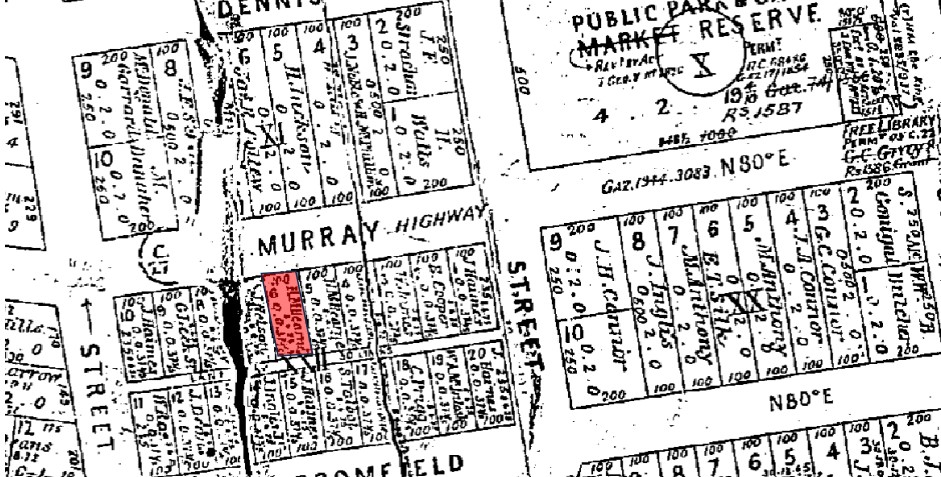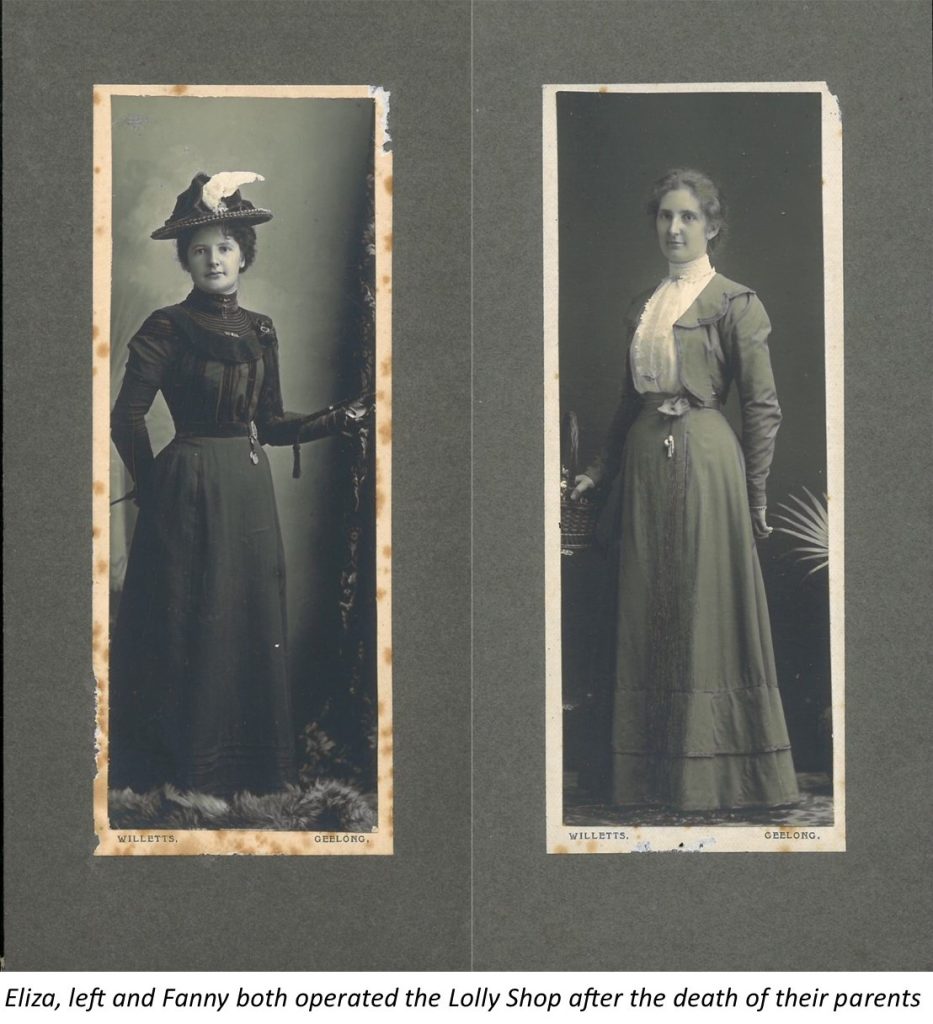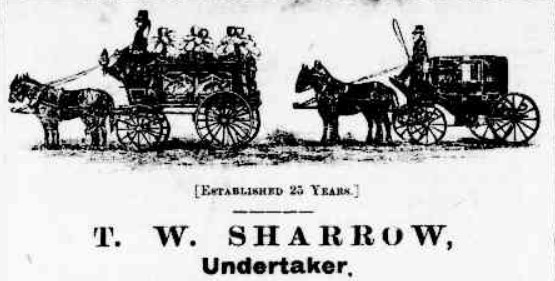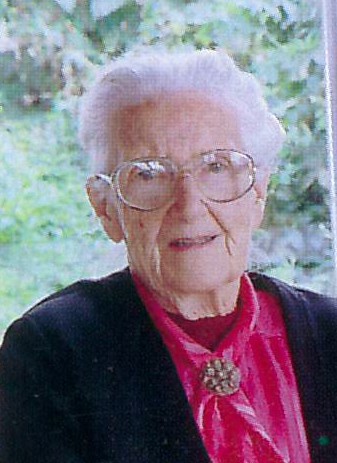Written by Nancy McGarvie nee Brown with additional information from Diana McGarvie
This confectionery business was started in 1902 by my Grand-father William, Grand-mother Bella & mother, Eliza Denning. The family had had experience in the lolly and other types of businesses, but were cautious about starting one in Colac, when they first moved from Geelong.
Prior to this, grocers were the only ones to sell sweets, they only had a limited variety and usually stocked the less expensive types – boiled and perhaps some chocolates, and mostly by the pound.
This business was more or less an experiment by the Denning family. The building was between Thompsons’ Plumbers and a Boot shop – Mr Moss, in Murray St. It was then, no.32, and later, no.158, which later still became Louise Roslyn frock shop, next to Coles. (It is now The Flower Room).

Dennings sold only the best quality confectionery and this in great variety. They also sold soft drinks, ice creams and, when they first came, afternoon teas.
In those days there were no ice-works in Colac, and refrigeration units were not yet invented, so the Dennings had to make their own ice-cream and freeze it with ice. This meant getting up at 5am in summer. The ice-cream was made from a secret family recipe, which was supposed to be very rich and nourishing containing many eggs, milk, sugar and was flavoured with vanilla. I never knew the recipe, so it WAS a secret!
The ice came by train about twice a week from Geelong (Geelong was the first place in the world to manufacture ice commercially). It was in large blocks about 1yard long and about 18 inches wide and 8 inches through. It was packed in sawdust in sack bags and in a wooden box. The ice-cream was made in a metal churn placed in a wooden bucket, and the space between the churn and bucket had to be filled with layers of ice and salt. All this had to be packed down tightly and the ice had to be chopped up with an ice pick first. This was a very exhausting job, as there were no electric mixers and turning the churn handle was hard work, as the cream began to freeze and thicken.
As stated before, the business was being ‘tried out’, so only a small supply of drinking and ice-cream glasses were sent from the Geelong shop for a start. (This being the business of the other Denning sister, Esther.) This shortage of glass-ware was the cause of a funny happening one evening.
At this time in Colac, the Yacht Club was in full swing and yachtsmen stayed at the lake until dark and then it was their habit to go to the Dennings for an ice-cream, cool drink and a talk. Dennings had an assistant who was rather inexperienced in the courtesies required of a waiter, and one night when the tea-room was crowded, this chap walked along the aisle between the marble topped tables, and Nana – (who was a very dignified English lady) was horrified to hear him say “Come on now – sock it in ter yer, we’re waitin’ on them glasses”. Nana was even more surprised to learn that the customers were not at all offended and did – promptly ‘sock it into themselves’ and smartly walked up and placed the empties in the counter!
When my mother, Eliza married, her place was taken by her sister, Frances. I have been told that my father, Milton, got to know my mother through his weakness for chocolate cream almonds. I believe he bought a bag every day, I suppose until the friendship was well established (he had a printing business, Brown & Holmes, close by in Murray street).

When I came on the scene, as first grandchild and niece, I had high priority on the guest list. My earliest memories are of frequent trips to the shop. Before I started school Aunty Fanny called up to our house very often in the morning and took me to the shop. I learned at an early age the standards of behaviour required by a fussy aunt and a dignified grandmother in a well conducted confectioners – no nonsense at all.
I sometimes meet people, whose memories go back to the shop, and the rows of dome topped, gleaming glass jars on the mirror backed shelves, which lined the entire wall behind the counter right up to the ceiling. There would be about 150 beautifully polished jars, each containing a different sweet or mixture. The contents of these jars were methodically changed…The shop girl had to start from the top shelf and put fresh sweets in two or three jars every day, put a slip of paper in the top with the date on, then repeat this until the end of the last shelf was reached – then start from the top again – thus by this process no stock ever became stale. They did not sell directly from the jars, but from boxes.
There was the penny and halfpenny drawer opening behind the counter – this was sometimes called ‘the tray’, it contained children’s novelties, such as silver sticks, silver sammies, rainbow balls, rainbow blocks, peanut blocks, licorice straps & twists, sherbert suckers, toffee lamp posts, and many other attractive sweeties. I was allowed to escort young patrons round behind the counter and supervise and wait while he or she made a choice. If the coin offered was sticky, Aunty would make me wash it before it went in the till. Aunty Fanny was always very particular about the appearance of the shop and the whole place was very much polished up. Mention of sticky pennies brings to mind the fuss that occurred if it was noticed that a fly had got into the window. There were no fly sprays or zappers in those days, so the fly had to be eliminated by some other means. The shop girl would be sent out to the street to bang on the glass to make the fly go to the back .Then when the fly was in the desired position, Aunty, who would be standing at a strategic point, at the ready – would jerk open the sliding door and with a duster either catch the fly or flip it out.
About once a month the commercial travellers came with their samples, and this was a wonderful treat for me. One of Mac Robertsons, was a very portly gentleman named Mr Sutton. He carried a very elegant display bag, real leather and it opened out in steps and stairs, like the sewing boxes of today, each compartment containing samples of sweets. When he had a new sweet he would pop one into my mouth, and one into his own, and I would feel very important giving my opinion on the merits of flavour, texture etc. Aunty, the traveller and I would be sitting at one of the little marble top tables while the order was being given. Then later, when the goods arrived, Aunty would let me know and I would help open the tops of the wooden boxes with a cold chisel and help tick off the invoice. They had very diligent dispatch men in those days as I don’t ever remember a mistake.
Some sweets, such as snow balls, moonshine biffs, marshmallow teddies, peppermints or conversations came in wooden boxes. These boxes were not returnable so Aunty used them for kindling. This wood, when burnt to coals, toasted bread beautifully. When I stayed overnight, I would be awakened to the sound of Aunty jumping up and down on a box to break it into a suitable size to fit into the stove – then the smell of lovely toast.


When I grew older, I was allowed to weigh the sweets, and soon learned how to swing the bag over to seal the corners. They had a couple of sets of small brass scales with weights. Then one day a set of “Dayton Computer” scales arrived. Of course the word ‘computer’ did not mean then, anything as complicated as it does today. The computer part was a built-in ready reckoner only, however, I thought these scales were the height of wonders! If when I was serving, I misjudged and gave a few more than asked for, I could stand back and follow the indicator and say in a very knowledgeable manner – “There are a few more there, will that suit you, that is one and threepence worth?” If the customer was generous, he would say “Yes”. If not, I would have to take some out.
There were many sweets made then that are never seen today. Do many people remember such things as Parma Violets, Floral Cashous, Sens-sens, miniature Menthol Jubes and very small fruit gum jubes. Of any of these I was only allowed to eat one now and again, as they were supposed to contain some ingredient that was not good for children. Parma Violets were mauve in colour and about 3/8’’ square, perfumed and flavoured with violets. Floral Cachous were very small, in daisy, heart and diamond shapes, all different flavours and perfumes. All these were very expensive then – which was about one shilling per ounce. One usually got more for money in comparison than today.

Thinking back to the days when my father did his courting; he helped Mother serve ice-creams one Christmas Eve. He slaved away for what seemed to him hours and counted that he had scooped out one hundred penny ice-creams, but he was somewhat deflated when he found the till contained only eight shillings and four pence!
Murray Street was a very happy and friendly place – there were many shops with dwellings at the rear or on top. In the morning the shop keepers or their staff would be cleaning the shop windows and sweeping the footpath, this was known as ‘doing the front’. The gutter-man would come and the water tap would be turned on at the corner, and all the dirt and dust of the previous day would be washed down the gutter. Discussions on the news of the day, births, deaths, weddings and funerals would all be talked about.
In those days, if a funeral passed the shop, Aunty would close the door, pull the blind down, but peep through the edge of it and report the number of vehicles, and who the mourners were following. Any men who happened to be in the street would remove their hats, and stand respectfully with heads bowed.

Back in my mother’s time, I believe funerals were more spectacular. The horses wore black plumes, and the undertaker in a black bell-topper and frock coat, walking backwards in front of the hearse, and waving his hands in an endeavour to line up the horses, looked more like a ballet dancer.
In fact, the day my grandparents came to Colac to inquire about the purchase of the shop, there was a funeral on, and all the shops were hung with black crêpe. They said the place had a most depressing appearance. However, it was evidently not always dismal, as they found when they came to live here.
Thursdays (market days) were very lively and happy days. Farmers, their wives and children were to be found all getting their week’s supply of sweets, to the accompaniment of Mr Johnstone’s voice from the cattle auctions in the sale yards at the rear. I had no idea of the meaning of his shouts.
Then of course, there were the well known ‘regular customers’. Some of these only had to put their foot on the door step, and Aunty knew exactly what they wanted. In fact, she prepared some orders before they came, and only had to hand them the bag of sweets and take their money.
It is so long ago, that it will not be out of place if the names are mentioned – there was Mr. Sewell’s chocolate mixture, Miss Johnstone’s Nestles Bars. Mr. Tom Johnstone always walked up to the little marble table, sat down and ordered a glass of Sarsaparilla, telling anyone who happened to be about the virtues of Sarsaparilla – “tonic for purifying the blood, tone up the liver, clear the skin etc.” He would sometimes invite someone to have a glass with him; it was bad luck if you thought the stuff tasted like toothpaste.
The shop stayed open every night till 9pm except for Sunday when it closed all day. The Colac Town Band used to play outside the Victoria Hall if an entertainment was on, and it was usual for young romantic gentlemen to buy their ladies a nice box of sweets to take to the concert. When I was old enough, I would judge the degree of affection of the gentleman who bought these boxes by the size of the purchase made. There was even one chocolate mixture called “Romance”. The first of my family’s confectionery shops in Geelong was started at the time of Queen Victoria‘s Jubilee and the Boer War. Many mixtures had names accordingly – Jubilee Mixture, Pretoria Mixture and Empire Mixture.
There were many gala/Empire days celebrated with street processions. There was a man who used to work at the Shire Hall and it was his job to organize the decoration of the street for these occasions. His name was Mr A. Handley, he would come into the shop with a bundle of flags and Chinese paper lanterns and say “Get these hung before Monday”, or whenever it was. Some people will remember the beautiful elm trees in Murray Street, well, wires were strung from tree to tree and flags and lanterns were attached to these.
One night when all was set for a procession, Murray Street looked very beautiful, each paper lantern glowing with the little lighted candle, everyone waiting for the band to lead the march and all keyed up to the utmost excitement – then it started – the band came marching down with great gusto , the large drum beating the time (my father played the drum), the Fire Brigade following, each fireman carrying a flaming torch held high, and also buckets of fireworks to be set off down in the Memorial Square. But – unfortunately, some of the sparks fell into the buckets of fireworks, and we had a very unexpected display. Lighted missiles flew under verandahs, scattering us all in fright, everyone screaming. Of course, I thought the end had come and was reduced to a state of trembling terror.
Christmas was the best time of all – the place would be decorated with little paper flags, garlands of tinsel and holly. The whole atmosphere was of good will and merriment. Even though one year the ginger beer bottles lost their corks and the contents frothed across the floor onto the street, the counter staff were too busy to attend to such a minor matter. Another year a whole box of aniseed balls collapsed and everyone was skating about, no one was upset, and it was all taken as part of the fun. One Christmas, a cheeky thief reached over the counter and the heads of customers, and just walked out with a nice display jar of lollies. Even this had to be overlooked.
Another time, not at Christmas, there was a very bold youth who was in the habit of thrusting his hand over the jars on the counter and taking a handful of whatever happened to be opened at the time. However, one of my Great Aunts was about and was awake to this practice, and she being older and wiser, fixed him. She prepared an open box of “Hypocrites” (these being hard-shelled, sugar coated liqueurs, containing very hot cayenne pepper, and they were very, very, very HOT), these she placed in a suitable position. The youth strode into the shop, quickly grabbed a handful of these sweets, and stuffed them into his mouth. Paused a moment, then went red in the face and bounded out to the gutter with the liquid oozing out the corners of his mouth.
The clientele consisted of young, old, rich and poor, in fact anyone who had a sweet tooth or perhaps no teeth at all.
There was a squatter’s wife; she always had her sweets put on her account. When she wished to settle the debt, she sent her children’s governess in to get the statement for the amount owing, while she waited out in a very stylish hooded buggy. On one occasion, the governess went out to her with the statement and ‘Madame’ got her cheque book out and (as ball point pens were not yet invented) she haughtily demanded – “Pen, ink and blotting papah!””
Nancy concludes her commentary with some thoughts of how life has changed over the years, and her family’s business success:-
“I often think it would be nice if we could return to the days when sweets were considered a real luxury and ice-cream a real treat. But when I think of the hard work churning up the ingredients and chopping up that ice and all the hazards of the whole lot melting if the weather turned too hot. Perhaps we are better off.
There was something my family said that I often think of – that is, that if times are bad, people will always buy small luxuries such as sweets – to cheer them up.
My mother and her family agreed that a retail business did better if: it wasn’t next door to a bank, it didn’t have steps at the entrance, and on no account should the proprietor, or any of the staff, stand in the doorway from the street”.

